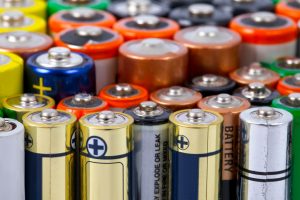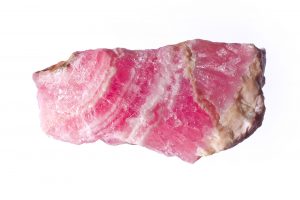Production
Manganese or manganese oxides are extracted in almost equal proportions either directly by mining or as so-called refined manganese as a by-product of the separation of other metals. In mining, South Africa, Australia and Gabon are the main mining countries, accounting for 58% of the manganese oxides extracted worldwide. Approximately 90% of the manganese oxides extracted are used for steel production, the remainder mainly as cathode material in batteries.
Manganese nodules, which in addition to manganese and nickel often also contain copper, cobalt, gold and silver, are not mined to date because mining would involve a high degree of technical effort and expense. Manganese nodules are located in various areas on the seabed and their extraction would destroy a sensitive and largely unexplored ecosystem.
Resource consumption during reprocessing
Around 70% of the ores processed in Europe are imported (as of 2020) and thus cause emissions through transport. In terms of the overall balance, however, emissions from transport are estimated to be low. No information is available on the consumption of natural resources such as forest or meadow areas for manganese extraction. There is also no detailed and publicly available information on energy consumption during processing, but since manganese is usually present as an oxide and mixed with other substances, energy-intensive steps such as the reduction of oxidic manganese ores with coal are necessary to obtain metallic manganese (see also the Material Information).
Safety
Manganese is an essential element for all living things. Nevertheless, high concentrations can have a harmful effect. For example, inhalation of dust containing manganese can cause coughing, bronchitis and pneumonia in humans. This is particularly relevant for occupational health and safety, as many processes (e.g. welding) produce dusts containing manganese oxide. As with other dusts, the small, respirable particles are particularly critical here. Furthermore, manganese and its compounds can have a neurotoxic effect, i.e. damage the nerves. At high concentrations, manganism occurs, leading to Parkinson-like movement disorders. At lower concentrations, symptoms such as headaches, memory disorders, dizziness, weakness and fatigue appear first.
Emissions
In metallurgical melting processes for the production of manganese and manganese ferroalloys, carbon is used as a reducing agent. This reduces metal oxides to the metal, which means that oxygen is removed. This results in significant CO2 emissions of ~1.4 t CO2/t metal. In 2020, the EU metals industry accounted for 2.5% of total CO2 emissions in Europe. This included the production of 1.4 million t of manganese ferroalloys. Mining produces overburden, most of which is left in the vicinity of the extraction sites. Washing the ore also produces sludge with relatively high metal contents, which contaminates rivers in some mining regions. Noise from mining also has a negative impact on the lives of animals and the local population.
Social aspects
The corporate concentration of mining manganese oxides is classified as low, so there are relatively many companies mining manganese oxides. This is an advantage, as it means that not only a few companies benefit and monopolies are less likely. The weighted country risk for the countries of origin of the manganese oxides, into which the indicators of the World Bank are incorporated (Worldwide Governance Indicators), indicates a medium risk. This means that there is room for improvement in points such as political stability, voice and anti-corruption in some producing countries. For responsible metal production, due diligence in supply chains is becoming increasingly important in the EU (German Supply Chain Act: Lieferkettensorgfaltspflichtengesetz). The law requires the documentation or certification of social standards and occupational health and safety, but initially only for companies with more than 3,000 employees.
Disposal and recycling
The availability of manganese oxides is assessed differently, some sources assume an almost unlimited availability, while others assume an availability of another 40 – 60 years. As a result, the incentive for material recycling has been low to date. There are legal requirements for recycling rates for battery components, but since manganese oxides have so far only been used in batteries in small proportions, the new EU regulatory framework for batteries does not specify a recycling rate for this material. One third of the steel produced in Germany comes from steel scrap. However, due to the large number of different types of steel, it is unknown how much manganese oxides are recycled from steel.
How to make the manganese more sustainable?
Scientists are researching more sustainable manganese production processes. This research aims to reduce CO2 emmissions. No substitutions are currently expected in the main applications, as manganese oxides are readily available and many new mining sites can still be developed.
Further information:
 Because manganese and its oxides occur everywhere in nature, e.g. in rocks, they are ingested through food. Steel cutlery also contains manganese.
Because manganese and its oxides occur everywhere in nature, e.g. in rocks, they are ingested through food. Steel cutlery also contains manganese.



 The human body replenishes its reservoir for manganese through food, i.e. the manganese is transported from the food in the small intestine into the body and distributed via the liver to other important organs that require the manganese for the function of certain enzymes. The daily intake ranges from 1 to 5 mg for an adult. It should be kept in mind that only about 10 % of the manganese contained in food is absorbed. The vast majority of 90 % is directly excreted . However, there is enough manganese in the diet so that no deficiency occurs in European countries. The manganese absorbed via the small intestine is not transported to the brain.
The human body replenishes its reservoir for manganese through food, i.e. the manganese is transported from the food in the small intestine into the body and distributed via the liver to other important organs that require the manganese for the function of certain enzymes. The daily intake ranges from 1 to 5 mg for an adult. It should be kept in mind that only about 10 % of the manganese contained in food is absorbed. The vast majority of 90 % is directly excreted . However, there is enough manganese in the diet so that no deficiency occurs in European countries. The manganese absorbed via the small intestine is not transported to the brain.